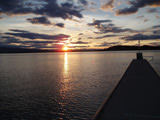The Ways of the River
The Flathead Watershed is the northernmost portion of the Pend Oreille River Basin, which is nested within the Columbia River Basin. The watershed covers approximately 200 miles (322 km) of land from north to south, and 90 miles (145 km) from east to west. The North Fork Flathead River originates in British Columbia and flows 31 miles (50 km) south to the U.S. border. The river then flows between Glacier National Park on its east and the Flathead National Forest on its west. The headwaters of the Middle Fork Flathead River flow from the Bob Marshall and Great Bear Wilderness areas. It flows between Glacier National Park to its north and Flathead National Forest to its south until it joins the North Fork of the Flathead River. The headwaters of the South Fork Flathead River are in the Bob Marshall Wilderness. The South Fork flows through Hungry Horse Dam and joins the Flathead just 10 miles (16 km) below the confluence of the North Fork and Middle Fork.
Together the North, South and Middle Forks of the Flathead River drain approximately 4,464 square miles (12,000 km2) with an average annual discharge of 9699 cubic feet (275m3) per second, as measured in Columbia Falls. The mainstem of the Flathead River then flows through the Flathead Valley from Columbia Falls to Flathead Lake.
The Whitefish River drains the northwestern mountain ranges, flowing through private, state, and Flathead National Forest lands. The Whitefish River joins the Stillwater River just 3 miles (5 km) before draining into the Flathead River, and 22 miles (35 km) before flowing into Flathead Lake. The headwaters of the Swan River are in the Swan and Mission Ranges, where it flows 66 miles (106 km) mostly north through private, state, and Flathead National Forest lands before entering Flathead Lake in Bigfork. The lower portion of the Flathead River empties from Flathead Lake south of Polson at Kerr Dam and flows south and west for 72 miles (116 km) through the Flathead Indian Reservation. The Jocko and Little Bitterroot Rivers, along with Crow, Mission, and Camas Creeks make up the main tributaries in the lower Flathead River. The Flathead River has an annual average discharge of 11,920 cubic feet (338 m3) per second at its confluence with the Clark Fork River.
 |
| click to enlarge |
| Figure 1.4: Flathead Lake Watershed Source: National Resource Information Center |
Rivers are an important part of the cycle of water between the land, the atmosphere, and the seas, and one of the most powerful forces shaping the landscape. Born from springs, snow fields, and melting glaciers, rivers flow through a variety of landscapes toward their final destination—the ocean. Rivers of the Flathead Watershed begin as streams flowing from Glacier National Park and the Livingston, Mission, Swan, and Whitefish Ranges. These small tributary streams tumble downward, over ancient bedrock, boulders, and cobbles, sometimes in steep waterfalls, cutting deep valleys as they move. Downstream the rivers become less turbulent spread laterally over flatter landscapes and meander through broad glaciated valleys. The icy blue waters of these rivers combine with the colorful cobbles and gravels to form one of the most striking features of the Flathead Watershed. The volume of water moving through the rivers increases as they are joined by tributaries and as new rainwater is added. The “alluvium”— cobbles, gravel, sand, and silt carried by rivers along their journeys—is deposited on the valley floors contributing to the creation of floodplains.

